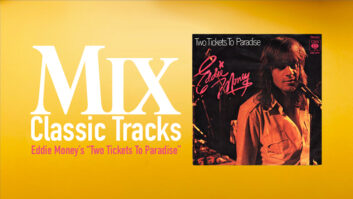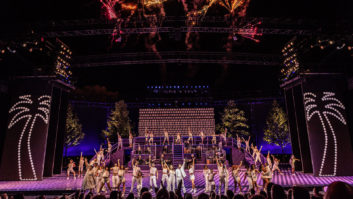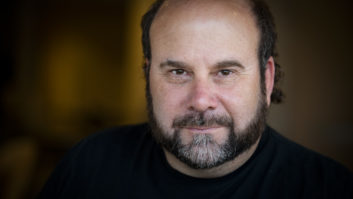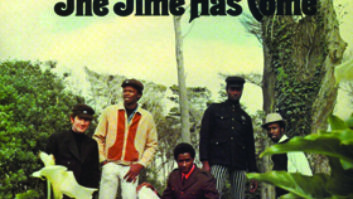The Offspring rock the Marine Stage during the Audio-Technica
co-sponsored Summer Sonic festival. The main stage in the Chiba
Marine baseball stadium featured an ample Clair PA with Avid
Venue desks at FOH and Yamaha PM5D RH consoles at monitors.
by Frank Wells and Yu Howe.

The familiar festival theme gets a twist each year with the Summer Sonic two-day concert event, held simultaneously in not one, but two Japanese cities: Osaka and Tokyo. Summer Sonic is the “biggest project of the year” for Creativeman Productions, according to company president, Naoki Shimizu. The availability of the primarily North American and European acts performing on the Summer Sonic stages is capitalized by the two-city methodology—the artists performing on the first day of the weekend event in each city are repeated on the second day on the sister city stages.
For 2010, the diverse alternating lineups included headliners Jay-Z and Stevie Wonder, Taylor Swift, Nickelback, The Offspring, The Smashing Pumpkins, Slash, Hole, Dream Theater, Sum 41 and dozens more acts, from veterans like a-ha to young bands like Surfer Blood and Yes Giantess, enjoyed by approximately 160,000 attendees across both venues.
Summer Sonic is designed to be commuter-friendly, which makes it more affordable and teenager “safe,” says Shimizu. As well as producing other smaller festivals, Creativeman, now wrapping up its 10th anniversary year, provides Japanese tour support for artists like Lady Gaga, Green Day and Muse, creating relationships that come in handy when Summer Sonic planning begins each October. “A lot of these artists, we’ve worked with for a long time,” says Shimizu, who has primary responsibility for booking acts for Summer Sonic; the festival is established to the degree that a number of artists now approach Creativeman about participating.
Tokyo hosts the largest number of Summer Sonic stages—six major stages with a number of supplemental venues spilling from the Makuhari Messe convention center to the adjacent Chiba Marine baseball stadium and grounds, including a beach stage on Tokyo Bay behind the stadium. Creativeman has some 40 employees on the ground, split between the two locations, with support from a number of SR companies including Clair Global and MSI Japan. Audio-Technica is both a major sponsor of Summer Sonic and a major factor in the event’s consistency—more than 1,100 Audio-Technica mics were available between the two host cities, with duplicate lists for corresponding stages that cover the gamut of A-T’s line from wireless to Artist Elite and 40 Series models.
Courtney Love fronts Hole on the Mountain Stage in the Makuhari
Messe center, aided by L-Acoustics V-Dosc and dV-Dosc PA.
Creativeman’s executive director, Ichiro “AO” Aono, leads the teams responsible for the legion of production details and coordination between the various system providers, artists and engineers. For the past nine years, Audio-Technica has had an ongoing, year-round working relationship with Creativeman, and A-T also provides staff at each major stage. Aono says that the transition between acts is optimum when bands take advantage of the Audio-Technica mics on hand—particularly the wireless systems frequency coordinated by A-T, in part because Japanese wireless systems are mandated as lower-powered transmitters.

Beyond the microphones, the sound systems for Summer Sonic are also consistent from city to city for the corresponding stages, with a variety of brands and configurations in use. The biggest stages—the Marine stage in Tokyo—sported Clair i-5s with i-4B mains, Clair BT-218 subs and JBL VerTec sidefills and delay cabinets. A variety of stage monitors were employed, with artists primarily providing their own personal monitor systems, where used. The monitor console was a Yamaha PM5D RH, with Avid Venue D-Show or Profile systems for FOH—a pair of the spec’d consoles were available for each stage to allow for more seamless transitions between bands, and the choice of Venue systems for FOH and PM5Ds for monitors were duplicated on the major stages.
On the Tokyo Mountain stage in the Makuhari Messe, more than 30 L-Acoustics V-Dosc and dV-Dosc cabinets were employed along with 20-plus SB 218 sub cabinets for mains. Stage monitors were a variety of MSI Japan custom cabinets, with additional models from L-Acoustics and Turbosound. The Tokyo Messe Dance stage employed a Meyer Sound Milo rig, with 700-HP subs and Galileo control. Stage monitors were from Meyer and Nexo. d&b audiotechnik J8 and J-Subs were the cabinets of choice for the Messe’s Sonic Stage, with TwoMix monitor cabinets.
Though digital consoles dominated, some venues like the Beach stage utilized a Midas Heritage 3000, with “mad scramble” manual recall between acts. As seems inevitable, a few acts had enough of a preference or the clout to bring their own consoles—the Offspring’s Midas Pro6, for example—or to have a custom configuration put together to travel with them between Summer Sonic sites, as with Nickelback’s Venue package.
“Pretty seamless” is how Taylor Swift’s monitor engineer, Vito Andrea, describes the transitions between venues. “All our gear was here, almost all the same staff was transitioned…they kind of came with the gear.” Summer Sonic has “pretty laidback” changeover times, creating “a relaxed festival, and we’re all happy to be here,” he elaborates. “They’re prepared, they planned it well, so we’re happy.”
Sum 41 FOH engineer John “JK” Kerns says the Summer Sonic formula “works great—you’ve got the same PA, and there’s at least one front-of-house guy and one monitor guy that know exactly what’s going on. They’re both people that can interpret as well; they’re both bilingual so it makes it really easy.” As you don’t have the opportunity to tune the PA yourself, says Kerns, the first song is “sort of a crapshoot when you un-mute. That’s the same with any festival.” That said, Kerns declares, “Everybody loves coming to work in Japan. Everybody in Japan really still takes pride in everything they do.”
Summer Sonic was a lovely experience for Nickelback’s FOH engineer,
“King” Orris Henry III who declares, “I love festivals…it’s not the
same routine.” Henry, shown here in the Chiba Marine stadium during
Nickelback’s soundcheck, pitched a hammock for himself underneath
the lighting/video platform to enjoy the downtime allowed by the
smooth running event.
That sentiment was echoed by first-time Japan visitor and Dream Theater monitor engineer, Michael Graham. “I am in awe of the professionalism and attention to detail that the stage crews have. MSI has done a great job satisfying Dream Theater’s audio spec, and they have really gone the extra mile to ensure that all the engineers that come through Summer Sonic have everything they need to have great shows. Not to mention the food over here is fantastic. The worst part of this little run we are doing over here is that it is too short.”

Ken “Pooch” Van Druten, FOH for Slash at Summer Sonic, polished the Mountain Stage house system to a level unattained by many, if not most, others sharing the venue. “It doesn’t hurt that the sources and musicians I am working with are top-notch,” says Van Druten. “As we all know, it is the source that matters.” That said, he gave a nod to Avid, Waves and Audio-Technica for helping him achieve his mix. “Slash is not traveling with a FOH desk,” says Van Druten, “so I have to advance every show with what desk I want. My preference right now is a Profile, which they had on hand at the Summer Sonic show. Every day, I walk out to FOH armed with my USB key of installers and my own Ilok. I am using Waves version 7, which has a bunch of wonderful plugs. I am also using an unreleased Waves plug called the C6 which is just fantastic.” C6 is based on Waves’ C4 multi-band compressor, adding two additional configurable bands, giving “the opportunity to really zero in on frequencies that are giving you trouble,” Van Druten elaborates, adding that he was in the process of writing presets for the plug-in in anticipation of its scheduled release this month.
Van Druten says the Summer Sonic relationship with Audio-Technica also suited his preferences, as the AT4050 is his “go to” mic on guitar cabinets. “To me, it is one of the cleanest acoustic-to-electric transformers out there. Whatever you put this mic in front of, it sounds like you are standing in front of [the source]. So it is a no-brainer when you have a virtuoso like Slash, whose tone coming out of the amps is amazing.”
If the enthusiastic crowds at Summer Sonic were ignorant of all the details involved in making the event a success, the sound crews were well aware. Slash monitor engineer, Kevin “Tater” McCarthy, declares, “For a festival this size, it’s impressive.” Van Druten says that Japan “is, and always has been, a place where they take special pride in making sure that they provide good services for us as engineers. It’s noticeable, especially since we just came from doing a bunch of other dates around the world; you come to Japan and everything’s right, you don’t have to worry about it.” Scott Edwards, at FOH for Coheed and Cambria, offered a characteristic summation of Creativeman’s Summer Sonic 2010, calling it “probably the most organized thing I’ve ever seen in my life.”





